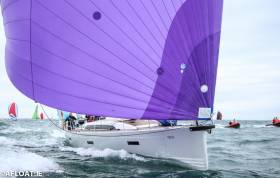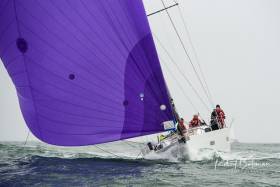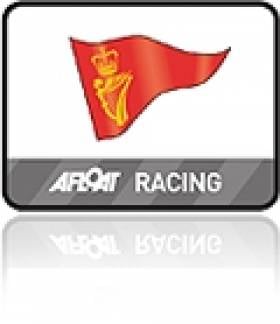Displaying items by tag: Freya
One final inshore race on May 1st completed the 2023 ORC European Championship, hosted by the Royal Malta Yacht Club, in which Kinsale yacht, the XP50 Freya, skippered by Conor Doyle, was competing.
The Kinsale crew competed in ORC A and finished eighth overall.
The division was won by Karl Kwok's Tp52 Beau Geste from Honk Kong with Claudio Terrieri's Italian Swan 45, Blue Sky, second on the same 12 points. Third was the Podesta family's modified First 45 Elusive on 17.
The elegant X-50 Freya was the only Irish entrant in the Championships as she was previously at the Middle Sea Race 2022 from Malta, a Grand Prix event in which she won the ORC 3 division.
2023 ORC European Championship results are here
Kinsale Yacht Club's Freya is Lying Third in Class in Middle Sea Race
Kinsale skipper Conor Doyle is lying third in class four after the first 24 hours of the Rolex Middle Sea Race.
The Irish XP-50 Freya from Kinsale Yacht Club was 30 minutes behind the Podesta family’s Maltese First 45 Elusive 2 through the Strait of Messina and is ranked third in class.
On board Freya – the sole Irish boat in the race – is a high-powered crew that includes Kelvin Harrap, Rory Harrap, Will Byrne, Barry Hurley, Nick Jones, Malcolm McCormick, Cian Guilfoyle, James Lyons, Conor Doyle and Nin O'Leary.
 The Ireland Freya crew skippered by Conor Doyle from Kinsale ready for the start of the 2022 Middle Sea Race this morning in Valetta harbour includes Kelvin Harrap, Rory Harrap, Will Byrne, Barry Hurley, Nick Jones, Malcolm McCormick, Cian Guilfoyle, James Lyons, Conor Doyle and Nin O'Leary
The Ireland Freya crew skippered by Conor Doyle from Kinsale ready for the start of the 2022 Middle Sea Race this morning in Valetta harbour includes Kelvin Harrap, Rory Harrap, Will Byrne, Barry Hurley, Nick Jones, Malcolm McCormick, Cian Guilfoyle, James Lyons, Conor Doyle and Nin O'Leary
This time last year, the race reporting was struggling to keep up with the pace of the frontrunners. The Maxi Multihulls had scorched 450 nautical miles of the 606nm course. What a difference a year makes: same or similar boats, polar opposite conditions. The story so far of the 43rd Rolex Middle Sea Race is one of determination and true grit, grinding out the miles one by one, sometimes taking more than hour to do so. Accepting pats on the back and slaps on the face from the wind is par for this edition. The fleet is currently spread between the Aeolian Islands north of Sicily, 220nm along the track, back to just north of Syracuse, a mere 83nm into the race. If it makes for hard watching from the shore, imagine life onboard.
 The MOD 70s Zoulou skippered by Erik MARIS and to leeward Snowflake skippered by Frank Slootman in the Rolex Middle Sea Race Photo: Kurt Arrigo
The MOD 70s Zoulou skippered by Erik MARIS and to leeward Snowflake skippered by Frank Slootman in the Rolex Middle Sea Race Photo: Kurt Arrigo
Currently, the MOD70 Mana, just north of Filicudi, is doing just over 7 knots, 2nm ahead of Maserati Multi70. Meanwhile, Zoulou, another MOD70, looks to have dived south towards Snowflake, perhaps to stay in or find better pressure. All four are well north of the rhumb line. The leading monohulls are right among them. The monohull maxi Bullitt, sailing parallel with Maserati at a similar speed, leads the larger Leopard 3 by about 3.5nm. According to the tracker, the French Ker 46 Daguet 3 – Corum – at Stromboli - is leading overall in the battle for the Rolex Middle Sea Race Trophy under IRC time correction, but this is really just an indication with so much of the race still to run.
Yesterday’s start from Grand Harbour was a foretaste of the 24 hours that would follow. The wind continually dropped in and out. Some boats were able to make fast progress out through the breakwater into open water. For others it was more miss than hit. The 55nm passage north to Capo Passero, on the southeast corner of Sicily, followed a similar pattern among all classes: head northeast out of the harbour for about 20nm before choosing the right moment to turn north to Sicily. Boat speeds went up and down with the wind strength until about halfway across the channel when the five racing trimarans took off, posting speeds in excess of 20 knots. The Maxi Monohulls did their best to keep pace hitting mid to high teens (at least according to the tracker). Mid-size boats also profited from this welcome respite from the light airs.
The relief did not last. While the multihulls kept in good breeze all the way to the beginning of the Messina Strait, which they reached around midnight, the wind dropped across the rest of the fleet as the leading monohulls reached Etna. In the darkness spotting what wind there was from signs on the water became nigh impossible. Sailing into traps seems to have been frequent and being the lead boat on the water was not always the best position.
Chocolate 3, for example, had sailed exceptionally off the start and Bouwe Bekking reported in during the early evening: “It’s a beautiful sunset, and up to now we’ve been sailing a very good race. François (Bopp) did a very good job at the start, wiggling ourselves through that, the crew work was good and, right now, Bullitt, one of the biggest in the fleet, is only one and a half miles ahead of us, so we can’t complain.” A few hours later at 0300 CEST, after making solid progress up the eastern seaboard of Sicily in line abreast with her IRC 2 class competitors, the Swiss boat looks to have hit a hole and had reason to complain. The boats further offshore just kept on moving, leaving Chocolate 3 behind. It has taken much of the day to get back on terms, and the crew will shortly be rounding Stromboli in a pack of other IRC 2 yachts.
Life onboard the fastest yachts in the fleet was easier until halfway to Stromboli. Having negotiated the narrow Strait in relatively good shape, exiting at 0130 CEST on Sunday morning, Paul Larsen reported in at dawn on the approach to Stromboli: “It’s oily calm conditions. We are holding on by our fingernails to a very tentative lead on the good ship Mana. The sun is just rising and behind us we can see Zoulou, Maserati and Snowflake. We are trying to hang on to every little gust we can get, as we glide along at 3.5 knots which, believe me, is hard fought for and very much appreciated.”
 Christopher Sherlock's Leopard 3, a Farr 100 is competing in ORC: X, IRC: Class 1 in the Rolex Middle Sea Race Photo: Kurt Arrigo
Christopher Sherlock's Leopard 3, a Farr 100 is competing in ORC: X, IRC: Class 1 in the Rolex Middle Sea Race Photo: Kurt Arrigo
For a long time, Leopard 3 looked to have the legs on the slightly shorter Bullitt. Their passage up the coast of Sicily was harder than for the multihulls, but easier than for many yachts behind. Reaching the beginning of the 20nm strait at about 0300 CEST, the two did well to get through it in two hours. Then shortly after exiting the Strait of Messina at around 0500 CEST on Sunday morning, Leopard appears to have got into difficulties, coming to a near standstill and losing 5nm to her Italian rival, a gap which has not changed greatly in the intervening hours.
The fight at the front of IRC 3 has been no less intense, with Lee Satariano and Christian Ripard on Maltese yacht Artie eking out a lead over Tonnerre de Glen from France and sistership Ino XXX from the United Kingdom. Just before midnight, off Syracuse, Artie and Tonnerre appeared to get stuck in glue while Ino XXX further offshore kept moving. Artie made better work of the conundrum than Tonnerre, but lost significant ground to Ino XXX. While these two have stretched away from the rest of their class, Artie has not yet been able to claw back lost ground as they approach Stromboli. Ripard and Satariano have done the race enough to know it is not over and if the forecast wind ahead of them is as tricky as it looks, there will be plenty of opportunities.
Yves Grosjean’s French Neo 430,NeoJivaro, also in IRC 3, gave a flavour of the experience so far for most of the crews: “It’s been a long night, we have been done a lot of sail changes… spinnakers, genoas, really everything. There isn’t a single sail we have not tried.”
The night to come does not look any easier, with a light easterly wind forecast for much of the hours of darkness, patchy throughout and diminishing over time. There will be no respite for any of the crews as they work hard to harness every puff and gain any advantage.
DAY 2 CLASS UPDATE 1700 CEST
IRC 1 AT STROMBOLI TRANSIT (12 YACHTS AROUND)
All but two of IRC 1 have passed the northernmost transit. Hungarian entry, Marton Jozsa’s Wild Joe is ahead of Jean Pierre Barjon’s French Botin 65, Spirit Of Lorina, on corrected by only 22 minutes, with Niklas Zennstrom’s CF520 Rán from Sweden a further five minutes back. On the water, Andrea Recordati’s Wally Yacht Bullitt from Italy holds a 3.5nm lead over the Spanish Farr 100 Leopard 3 led by Chris Sherlock, which in turn is 7nm ahead of Wild Joe. All are now sailing west from Stromboli at between seven and eight knots.
IRC 2 AT STROMBOLI TRANSIT (3 YACHTS AROUND)
The German TP52 Red Bandit skippered by Carl-Peter Forster, Eric de Turckheim’s French NMYD 54 Teasing Machine… and Gerard Logel’s French IRC 52 Arobas2 hold the top three spots separated by an hour on corrected time. Meanwhile Hagar V (ITA), Daguet 3 – Corum (FRA), Maverick (AUS) and Chocolate 3 (SUI) are close behind very near to passing the Stromboli transit.
IRC 3 AT MESSINA TRANSIT (5 YACHTS THROUGH)
Only five yachts have made it past the Messina transit. James Neville’s British HH42 Ino XXX holds the lead from Maltese entry Artie, co-skippered by Lee Satariano and Christian Ripard, by 23 minutes. Gilles Caminade’s Ker 40 Chenapan 4 (FRA) is in third, three hours off the current pace. Tonnerre De Glen (FRA) and Mahana (FRA) are the other two through. Ino XXX and Artie are approximately 22 nautical miles from their next transit at Stromboli.
IRC 4 AT MESSINA TRANSIT (3 YACHTS THROUGH)
The leading boats on the water in IRC 4 were registering over nine knots of boats speed on exiting the Strait of Messina, but slowed as they entered the open water north of Sicily. The Podesta family’s Maltese First 45 Elusive 2 has made it through the narrow strait and is ranked in pole position after time correction. Philippe Frantz’s French NMD 43 Albator was the first in class to exit the Strait of Messina and is ranked second. Conor Doyle’s Irish XP-50 Freya from Kinsale YC, was 30 minutes behind Elusive 2 through the Strait and is ranked third in class.
IRC 5 AT MESSINA TRANSIT (1 YACHT THROUGH)
Gianrocco Catalano’s Italian First 40 Tevere Remo Mon Ile is the first boat in the class to exit the Strait of Messina and is likely leading by a substantial margin after IRC time correction. According to the tracker, second in class and on the water is Ed Bell’s British JPK 1180 Dawn Treader. Johnathan Gambin’s Maltese Dufour 44 Ton Laferla lies in third in class. A special mention for Beppe Bisotto’s Fast 42 Atame racing two-handed with Catherine Jordan, which is currently fourth in class.
IRC 6
It has been slow going in IRC 6 with most of the fleet due east of Etna having raced less than 100 miles in the first 24 hours. However, a leading pack of four boats has made a significant gain after finding good breeze at around midday. Massimo Juris’ Italian JPK 1080 Colombre leads the class on the water, about 10 nm from the exit to the strait. Maltese J/99 Calypso, skippered by Seb Ripard, is about two nm behind Colombre, but according to the tracker is ranked first by about an hour after IRC time correction. The double-handers Ludovic Gérard’s French JPK 1080 Solenn for Pure Ocean and the American Sun Fast 3300 Red Ruby, raced by McKee and Strum-Palerm, are in a close-fought duel. Solenn is just ahead on the water, but appears behind Red Ruby after time correction.
See live tracker below
1700 CEST - The 42nd Rolex Middle Sea Race has so far lived up to expectations, putting on a sensational start. All 114 yachts got away cleanly in a fresh south-easterly breeze that built from 10-12 knots, in the confines of Grand Harbour, to 15 knots plus once past the outer breakwater. From the smallest to the largest, the slowest to the fastest, it was a magnificent sight. The impressive bastions of Valletta, Vittoriosa and Senglea provided a fitting setting for this highly competitive fleet, as cannon fire signalled each start.
The fleet is currently spread between Syracuse to the north and midway between Malta and Sicily, to the south. Jason Carroll’s MOD70 Argo (USA) is leading on the water, with Skorpios, the ClubSwan 125, the first monohull. The race is on for the leaders to reach the Strait of Messina where the current is now heading north and turns foul just before 2100 CEST. The Maxi Multihulls are hoping to keep enough of the breeze to the east of Sicily to make a seamless trip into the Tyrrhenian Sea and into the brisk easterly established to the north around Stromboli. This morning, Will Oxley, navigator on Mitch Booth-led Comanche (CAY), was uncertain if the Maxi Monohulls would be able to take advantage of this window of opportunity, but still felt confident that a new race record is on the cards.

Class Starts
The Multihull class was the first off the start line at 1110 CEST. Antoine Rabaste’s Ultim’Emotion (FRA) and Riccardo Pavoncelli’s Mana (ITA) hit the line at speed, with Maserati Multi70 in the second row and Argo even further back. A wind shadow created by Fort St Angelo, a feature of every subsequent start, compressed the fleet, but it was Mana first out of the harbour. Spare a thought for the intrepid cruising trimaran Minimole (ITA), a Neel 47, also part of this start. Aldo Fumagelli and his crew must have watched in wonder as the four mega-beasts sped away. At least they will have comfortable overnight accommodation to look forward to. The three 70 footers made short work of the passage to Capo Passero, at the southeast corner of Sicily, and the first transit point of the course. Touching 20 knots at time, Mana, Argo and Maserati were virtually line abreast, with Ultim’Emotion on their hip. At 1432 CEST Maserati reached the Sicilian shore with a 10-minute lead on the water over Argo and Mana. Giovanni Soldini is showing no intention of relinquishing his line honours crown, and perhaps multihull race record, without a fight.

The final start, and seventh, of the day was reserved for the fastest monohull entrants and some of the largest. The group ranged in size from the clutch of 52 footers up to the, frankly, overpowering 42.56m/140ft Skorpios. The towering mast of the Swan yacht is taller than the Saluting Battery from where the Royal Malta Yacht Club race team, led by Principal Race Officer Peter Dimech, controlled proceedings. Skorpios and the 30.48m/100ft Comanche took some time to wind up to warp speed. Both were caught briefly in the irritating wind hole just off the line. Meanwhile, George David and his five-time line honours winner, the 27m/88ft Rambler, took full advantage to lead the class out of the harbour and to the first mark of the course just past the breakwater. By Dragonara, proper order had been established with Skorpios leading Comanche and Rambler at the turn to the north. Compared to the Maxi Multihulls, the leading monohulls made the crossing to Sicilian at a relatively pedestrian pace of around 13 knots, arriving at Capo Passero later in the evening.
Congested Starts
The slowest yachts in the international fleet that represents some 25 countries set off at 1120. Their start was a less dramatic than the spacecraft that had preceded them, but it was full on. Some 28 yachts filled the gap between Valletta and Fort St Angelo. The favoured position appeared to be just beyond the mid-point of the line, towards the pin, avoiding any issues caused by the sheer-sided St Peter and Paul Bastion beneath the Upper Barrakka Gardens.
Unsurprisingly it was a Maltese boat, Calypso, that launched. Even less surprisingly, the tiny J/99 was crewed by the Ripard family, whose name is etched into the history of the race. Leonardo Petti’s well-sailed J/109 Chestress (ITA), Noel Racine’s JPK 1030 Foggy Dew (FRA), and the JPK 1080 Rossko (RUS) of Sergei Desukevich all made great strides in the early stages, as did Kiboko Tatu (USA), George Greer’s Arcona 380. These smaller yachts are the real spirit of the Rolex Middle Sea Race. It will take them between four and six days to complete the course. In the words of Gabriele Spagiari, skipper of the smallest competing yacht, the Hanse 311 Catina 4 (ITA): “It is a challenge within a challenge. The first part is to complete the race, the second is to do our best against boats that are all bigger than us!” These yachts will experience more weather than most over the course area: good, bad and indifferent. This year they are likely to be buffeted twice - first, at dawn on Sunday 24 October, when upwards of 25 knots are forecast east of Sicily, and then again on Monday afternoon around the Aoelian Islands, where similar windspeeds are expected. For one member of the otherwise experienced crew on the Russian J/99 Space Jockey, taking part in his first ever sailing race of any kind, the first couple of days could be a proper baptism.

The third start was another congested line, with all the action at the St Angelo end. Timofey Zhbankov’s 1080 Rossko Racer (RUS), Tom Kneen’s JPK 1180 Sunrise (GBR) (winner of the 2021 Rolex Fastnet Race), the First 40 Tevere Remo Mon Ile (ITA) and the J/111 Blur (SWE) (winners of the 2021 Yachting Malta Coastal Race on Wednesday) all took off like scalded cats. The Italian crew would reach the Dragonara turn first. Meanwhile, the all-American crew of J/122 Noisy Oyster made a more restrained start. The crew, led by John Duncan, is a mix of seven US West Coast and Mid-west friends, who have raced together for many years. According to crewmember Marian Lambrecht Hoskins, whose husband John is the navigator, “This is a bucket-list race in a beautiful location. We are a little nervous because the conditions look challenging at times, in keeping with the race’s reputation. But overall, we are excited.”
Expectant Starts
The next three starts saw some of the highly fancied yachts get underway. The Maltese contingent included the Podesta-led First 45 Elusive 2, winners of the past two-editions; the HH42 Artie III, with multiple winners Lee Satariano, Christian Ripard (with more than 30 races under his belt) and Timmy Camilleri (on his 28th race); and Jonathan Gambin’s Dufour 44 Ton Ton Laferla, third overall under IRC in the 2020 Rolex Middle Sea Race. Potential international contenders included French yachts, Jacques Pelletier’s Milon 41 L’Ange de Milon; Federic Puzin’s Ker 46 Daguet 3 – Corum; and Eric de Turkheim’s NMYD 54 Teasing Machine with ocean race winner Laurent Pages in the crew. The Swiss Cookson 50 Kuka 3 skippered by Franco Niggeler will relish the more challenging elements, while British entrant James Neville with the HH42 Ino XXX will be looking to better his second place in this summer’s Rolex Fastnet Race.
Race tracker here
In a warm-up for October's Middle Sea Race, in which Cork yacht Freya is the only Irish entry, the Kinsale Yacht Club XP50 skippered by Conor Doyle took fifth overall on IRC and ninth in line honours in this week's Palermo to Montecarlo Race.
Following line honours and second overall in June's Dun Laoghaire to Dingle Race, Doyle has shifted his campaign to the Mediterranean with a top-rated crew, as Afloat reported earlier here.
The Palermo to Montecarlo Race is organised by Circolo Della Vela Sicilia, in partnership with Yacht Club de Monaco and Yacht Club Costa Smeralda; it’s become a major event on the calendar since its launch in 2005.
This year it again attracted some of the Med's leading Maxis in an international fleet of 56 boats.
Last Monday night, after 59 hours 3 minutes 8 seconds that Guido Miani from the Yacht Club de Monaco associated with Furio Benussi crossed the finish first in elapsed time to take line honours of the 16th Palermo-Montecarlo on Arca SGR. It is his fourth title on this Mediterranean classic, having won it twice in corrected time (2007 and 2008) and elapsed time (2013).
Behind Benussi, it was a nail-biting battle for 2nd place between Pendragon VI and Aragon, won by Laurie Davidson 69 Pendragon VI over the last few metres.
Conor Doyle’s XP50 ‘Freya’ from Kinsale Yacht Club starts in Saturday's 450-mile Palermo to Montecarlo Race as the sole Irish entry in the Italian classic.
An international fleet of 56 boats will race in the fixture organised by the Circolo Della Vela Sicilia, in collaboration with the Yacht Club de Monaco and the Yacht Club Costa Smeralda.
Doyle, who was the line honours winner of June's Dun Laoghaire to Dingle Race and finished second overall on IRC after a sensational kitesurfer rescue, has assembled a top-class crew for the Italian offshore fixture.
Sailing on the Kinsale yacht is Cork Harbour's Nin O'Leary as Navigator and Dun Laoghaire's Will Byrne as part of the ten-man crew. See full crew list and positions below.
Also on board is Dublin Professional sailor James Carroll who overcame the disappointment of a dismasting in 2018 to win class two of October's Middle Sea Offshore Race in 2019 on Stefan Jentzsch's Black Pearl.
The 16th edition of the offshore race is under both IRC and ORC ratings and starts at noon from Mondello’s Gulf and finishes in the Principality of Monaco.
Download the IRC entry list below.
 The 450 mile Palermo to Monte Carlo Race course
The 450 mile Palermo to Monte Carlo Race course
 Conor Doyle’s XP50 ‘Freya’ crew from Kinsale Yacht Club for the Italian race
Conor Doyle’s XP50 ‘Freya’ crew from Kinsale Yacht Club for the Italian race
Palermo to Monte Carlo Race Yacht Tracker Here
With the leading Fastnet Race multihulls well round the Fastnet Rock this morning (fleet leader Gitana 17, the Ultime 32 aka Maxi Edmond de Rothschild, was first at the turn at 0633 BST) the bulk of the fleet are still struggling with calms and flukey headwinds in that tricky area off the southwest of England between the Lizard and Start Point writes W M Nixon
As the faster big boats have found - for not all the big boats have been fast - once you get past the Lizard, you begin to feel the benefit of an Atlantic southwest breeze, and though Gitana (as we apparently now have to call her) faced a few minutes of stoppage with her closest rival Macif in a freak calm calm patch northwest of the Isles of Scilly in the small hours, generally for the passage across the Celtic Sea they were looking at speeds at the top end of the 20-30 knot mark, and the Fastnet was ticked off more or less on schedule.
They are already well on their way to Plymouth, with Macif grabbing the lead around 0800 hrs. However, for the smaller multi-hulls and the enormous fleet of mono-hulls, only their leaders have got through the invisible barrier south of the Lizard.
But now some well-known names are beginning to come clearly to the fore past the Isle of Scilly as they strike out across the Celtic Sea on track for The Rock, with George David’s Rambler 88 looking set to take over the line honours lead from Seng Huang Lee’s 100ft Scallywag from Hong Kong, a boat with a storied past – apparently at least some bits of her were once in one of legendary Australian Syd Fischer’s Ragamuffins.
However, at the moment the real story in the big mono-hull line honours battle is the excellent showing of David & Peter Askew’s Volvo Open 70 Wizard from America. She’s noted as a star performer on the west side of the Atlantic skippered by Charlie Enright, she won the Transatlantic Race in July, and now she has come as cleanly as possible through the slough of despond which is the current state of the sea areas south of Falmouth and Plymouth, and she’s right there on Rambler 88’s tail, third for line honours and currently leading IRC Overall.
Meanwhile back in the crowd which is still moving slowly while often turning to windward off the south coasts of Cornwall and Devon, with 390 boats under IRC rating and all placings up-dated by YellowBrick ever quarter of an hour, the continually-changing placings inevitably mean that many boats are going to have their Andy Warhol 15 Minutes of Fame.
One such was Conor Doyle’s handsome Xp 50 Freya from Kinsale (her crew including Olympic campaigner James Espey) which was in the limelight as overall leader at one stage of Class IRC 1A. She has currently slipped back to 11th OA in Class 1A but is in contention.
However, in Class 1 and 1A and indeed the fleet generally, the best Irish hope lies with Kenneth Rumball and Barry Hurley on the Swedish-owned Ker 40 Keronimo – they currently lie 19th overall in IRC, fifth in IRC1 and fourth in IRC1A, and while still to the southeast of the Lizard, they’re well placed and making steady progress in the spreading sou’west breeze.
Astern, however, the fleet is so tight-packed and struggling to make headway that scrolling back on the tracker is a bit like looking into a can of worms, but hopefully, by this afternoon they’ll all feeling a firmer workable breeze, and a leading wind from Land’s End to the Fastnet.
Yet it’s beginning to look like a big boat race. The sou’wester will freshen out in the Celtic Sea this afternoon to speed the leaders to the rock and back again, but then after the freshening has gone through, the expectation is of veering which may even provide some of the tailenders with a beat to the Fastnet.
Race Tracker & Leaderboard here
Doyle's Xp50 'Freya' in Fine Form for Yacht Race From Kinsale to Monkstown
Kinsale Yacht Club's 'Mary P' Race and Cruise organised by Neil Prendeville from Kinsale to Monkstown on Saturday morning took just two hours for Conor Doyle's new Freya XP50 to complete.
The six KYC boats in the 'All In' Echo, IRC and White Sails fleet then joined the Cork Harbour Cobh to Blackrock Race later that day. See our Cobh to Blackrock Race photo gallery by Bob Bateman here.
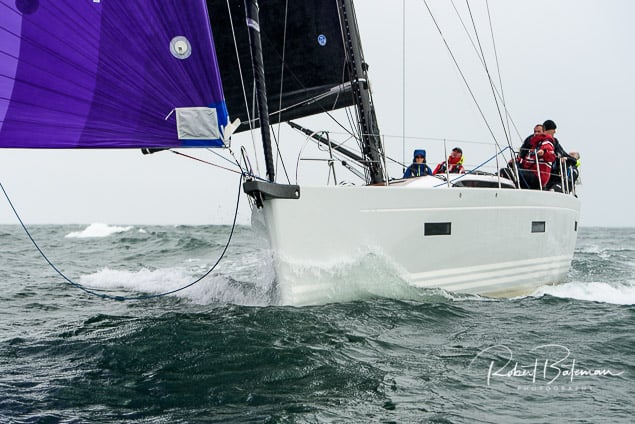 (Above and below) Conor Doyle's Freya in the race from Kinsale to Monkstown Photo: Bob Bateman
(Above and below) Conor Doyle's Freya in the race from Kinsale to Monkstown Photo: Bob Bateman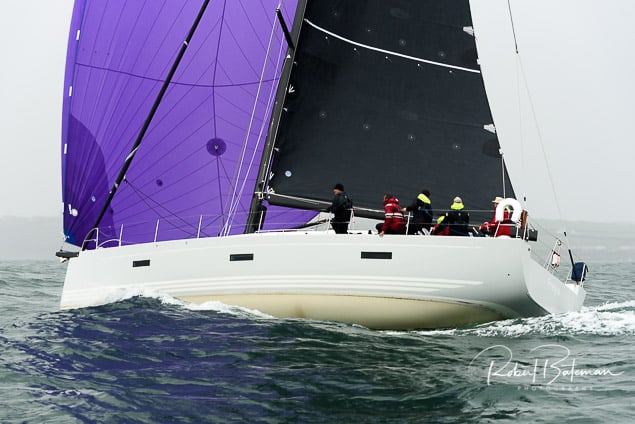
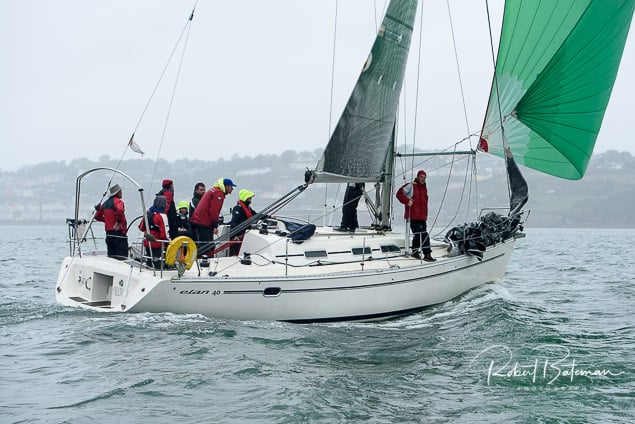 The Elan 40 Chancer (Carroll Bros)
The Elan 40 Chancer (Carroll Bros)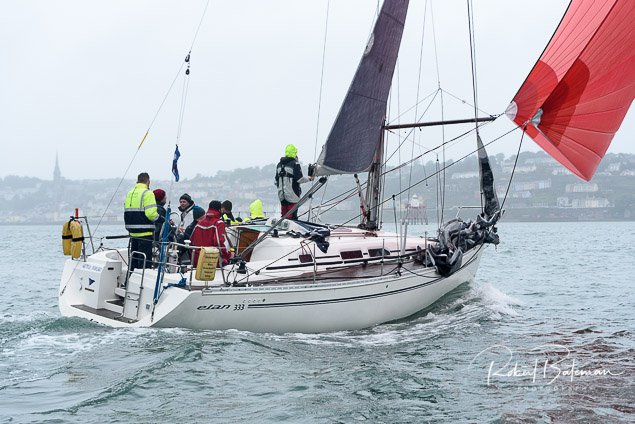 The Elan 333 Artful Dodger skippered by Finbarr O'Regan Photo: Bob Bateman
The Elan 333 Artful Dodger skippered by Finbarr O'Regan Photo: Bob Bateman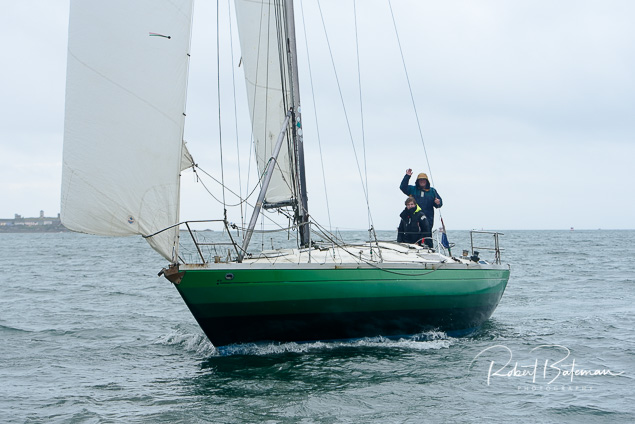 KYC's Chameleon (Padraic O'Donovan) Photo: Bob Bateman
KYC's Chameleon (Padraic O'Donovan) Photo: Bob Bateman
Tiger Leads Class III in Royal Cork October League (PHOTOS HERE)
What a day this Sunday's racing turned out to be. From the moment one turned the corner on to the Crosshaven road at Carrigaline there was magic in the air writes Claire Bateman. The sun was shining, the trees were resplendent in their multi colour seasonal changes and the line of cars making their way to the Royal Cork Yacht Club was non-stop. The forecast said Sunday was going to be a very nice day with lots of sunshine but nowhere did I hear anyone say anything other than winds would be light and, so it seemed, until a flag outside one of the supermarkets on the road to Carrigaline seemed to be moving pretty nicely and was a taste of things to come.
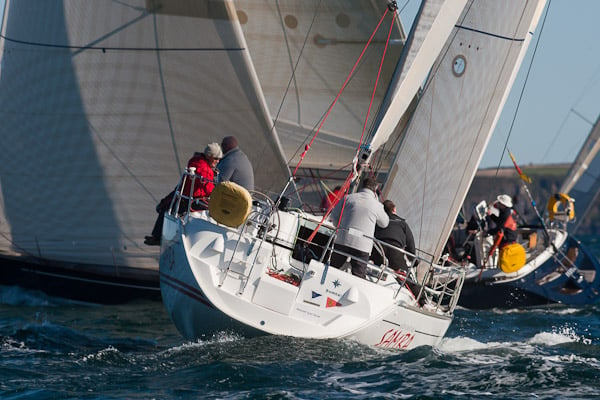
Tight racing in the penultimate race of Royal Cork's October League. Photo: Bob Bateman. Scroll down for more photos from yesterday
Classes Zero, One and 1720s got the nicest wind on the laid course to day. Race Officer Richard Leonard and his race committee in Capta Ventum, kindly provided by Pascal Healy, certainly made the best of the day. Today Richard decided on a change of format and started the 1720s first followed by Classes Zero and One together and then Class Two. He gave the fleets short courses providing very tight racing ensuring the crews had plenty of hard work and also providing very exciting viewing with a few heart-stopping moments. The 1720s, Zero and One did three rounds and Class Two did two rounds. With a northerly breeze of some 10 knots gusting to 12 and occasionally 14, it was to provide a tantalising taste of what was to come and there was no disappointment. Voices that hadn't needed to be raised at marks on previous Sundays found the necessity to make themselves heard today and the action was fascinating with hard work on the boats but a sense of great sailing exhilaration emanating from them.
Coming into race two of the day the skippers and crews had got the bit well between their teeth and were all like bucking broncos at the start line. In Class Zero there was an individual recall sounded. Jump Juice and Freya answered the call immediately and returned to restart and after some little while Gloves Off returned and while not knowing the reason why, one can only assume the helmsman perhaps was not quite convinced he had been over but then decided to return having considered it. Again the wind duly obliged and as in the first race, there were boats to the left, boats to the right and boats pretty well everywhere one looked. In Class Zero Tom Roche's Meridian from Kinsale had been performing extremely well but was slightly under
crewed today and was unlucky enough to have an incident at the weather mark in this race and after that things just did not go their way and they retired. This must have been disappointing as they had been doing so well. With Jump Juice winning the first race today and Gloves Off taking the second race and first overall to date in the series, the last day of racing next Saturday will be crucial as these races will be non discardable.
Race Officer Anthony O'Leary stood in to day for David O'Brien and the committee boat Sabrone was again kindly provided by Admiral Paddy McGlade. It was not such a lucky day wind wise inside the harbour for Classes Three and Four and White Sail 1 and 2. There was also extremely low water to day
and some of the skippers mentioned they had in fact touched rocks. Nonetheless they enjoyed good racing if at a somewhat lower pace than the competitors on the laid course.
At this point in time Class Three IRC looks like a two horse race with Tiger on 9pts followed by Bandit on 11pts. Class Four has a very similar situation with Sundancer on 9pts followed by Granny knot on 11pts. In White Sail 1 IRC Minx 111 had a good day to day with a first and second and currently has 7pts overall and the two big boats in the fleet Chancer from Kinsale and Aisha from RCYC are on 14pts each. In White Sail 2 IRC Plumbat is on 6pts overall with Phaeton on 9pts and Silk Breeze on 12pts.
And so we are coming to the final race of this exciting series. All competitors should note carefully that racing will take place on SATURDAY NEXT OCTOBER 30TH. The prize giving dinner will take place that evening at the Club House .
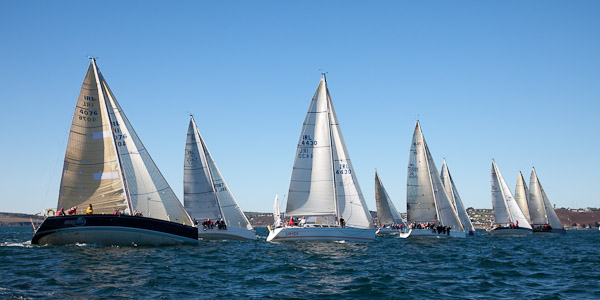
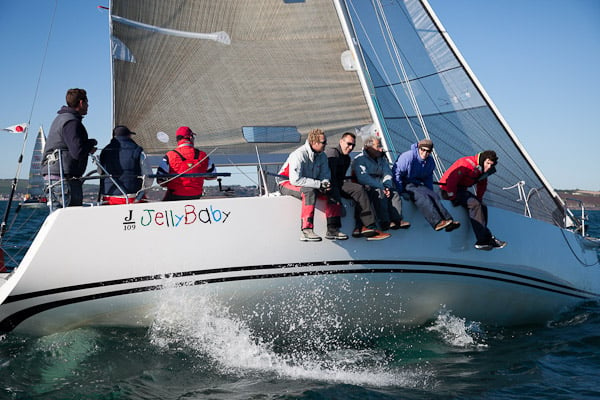
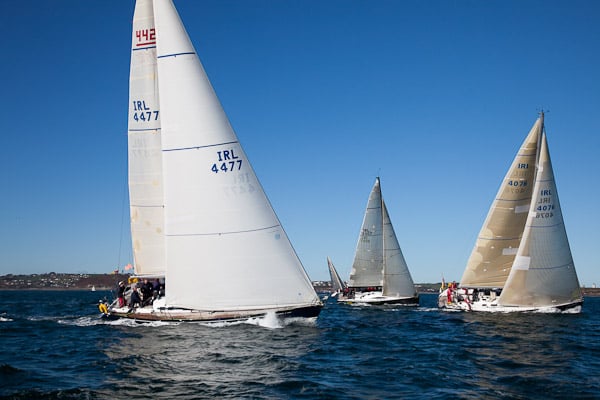
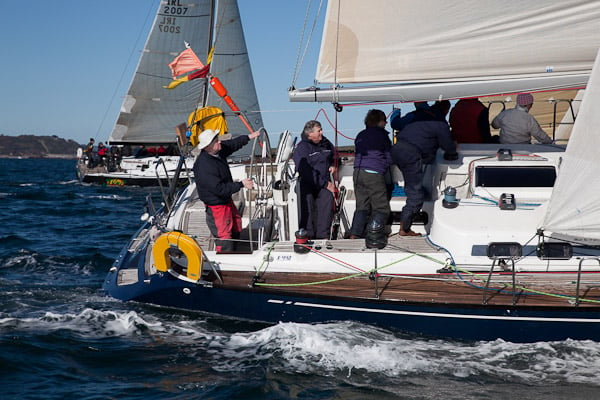
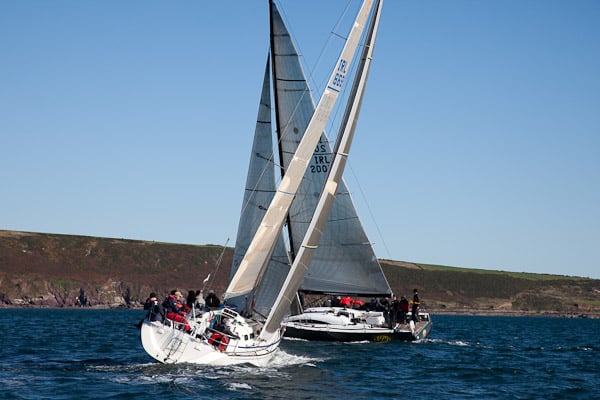
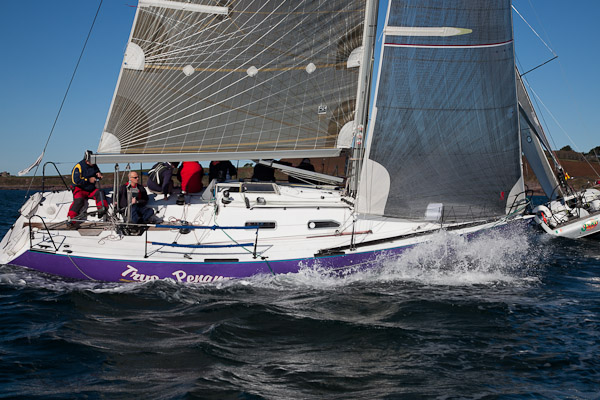
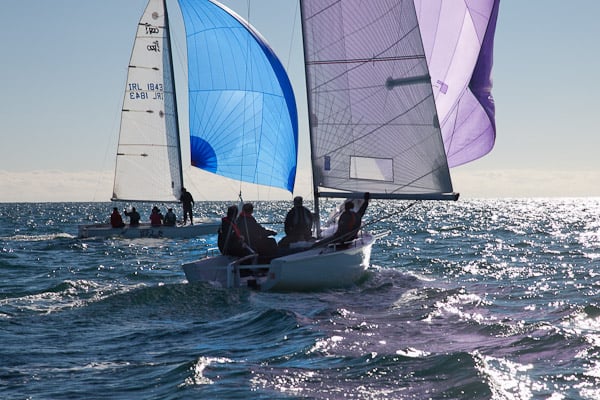
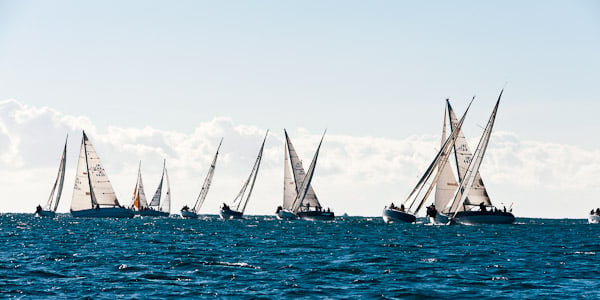
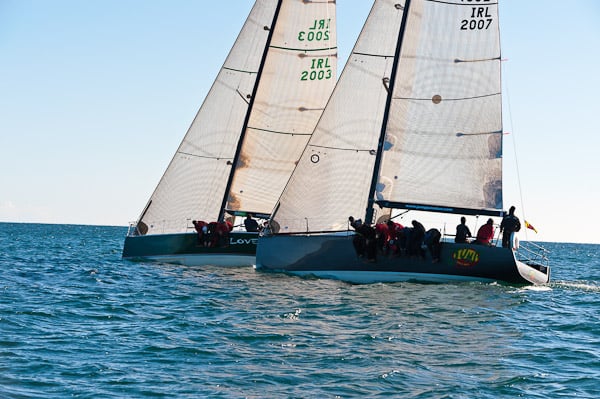
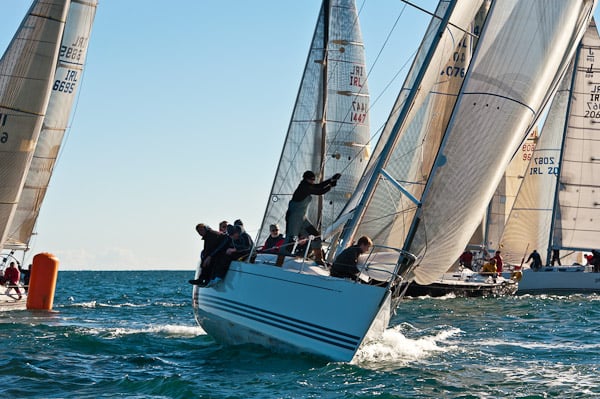
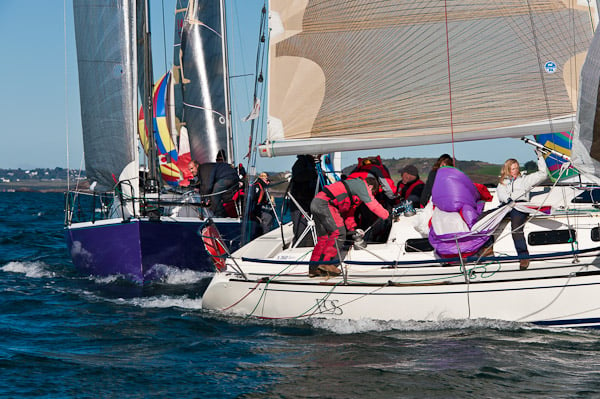
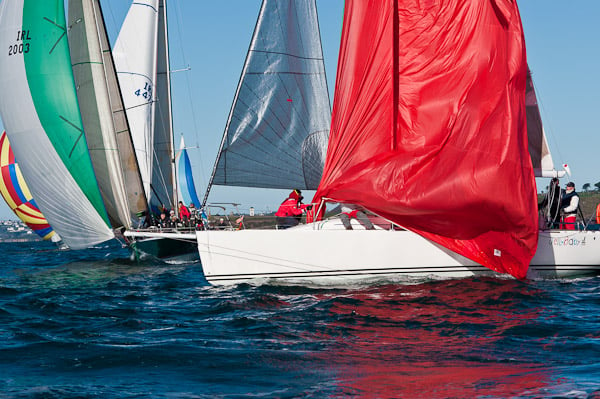
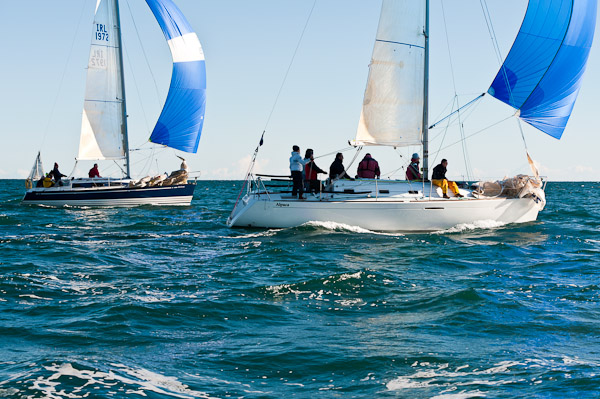
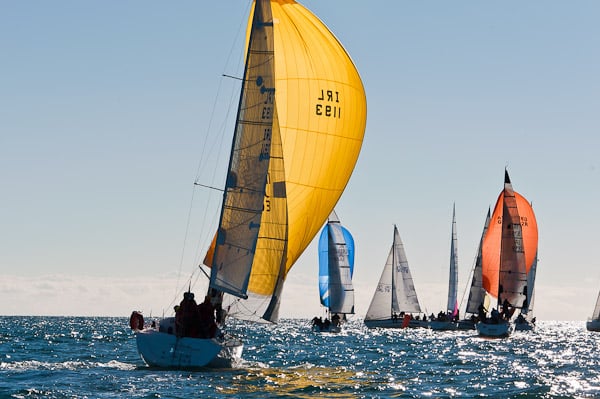
MORE OCTOBER LEAGUE GALLERY IMAGES HERE


























